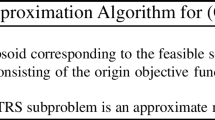Abstract
The deepest, or least shallow, cut ellipsoid method is a polynomial (time and space) method which finds an ellipsoid, representable by polynomial space integers, such that the maximal ellipsoidal distance relaxation method using this fixed ellipsoid is polynomial: this is equivalent to finding a linear transforming such that the maximal distance relaxation method of Agmon, Motzkin and Schoenberg in this transformed space is polynomial. If perfect arithmetic is used, then the sequence of ellipsoids generated by the method converges to a set of ellipsoids, which share some of the properties of the classical Hessian at an optimum point of a function; and thus the ellipsoid method is quite analogous to a variable metric quasi-Newton method.
Similar content being viewed by others
References
S. Agmon, “The relaxation method for linear inequalities”, Canadian Journal of Mathematics 6 (1954) 382–392.
R.G. Bland, D. Goldfarb and M.J. Todd, “The ellipsoid method: A survey”, Operations Research 29 (1981) 1039–1091.
T. Bonnensen and W. Fenchel,Theorie der Konvexen Körper (Springer-Verlag, Berlin, 1934; Reprint: Chelsea, New York, 1948).
L. Dantzer, D. Laugwitz and H. Lenz, “Über das Löwnersche Ellipsoid und sein Analogon unter der einem Eikörper einbeschriebenen Ellipisoiden”, Archiv der Mathematik 8 (1957) 214–219.
J.L. Goffin, “The relaxation method for solving systems of linear inequalities”, Mathematics of Operations Research 5 (1980) 388–414.
J.L. Goffin, “On the nonpolynomiality of the relaxation method for systems of linear inequalities”, Mathematical Programming 22 (1983) 93–103.
J.L. Goffin, “Convergence of a cyclic ellipsoid algorithm for systems of linear equalities”, Mathematical Programming 22 (1982) 239–260.
J.L. Goffin, “Variable metric relaxation methods, part I: A conceptual algorithm”, Technical Report SOL 81-16, Systems Optimization Laboratory, Operations Research Department, Stanford University (Stanford, California, 1981).
J.L. Goffin and A.J. Hoffman, “On the relationship between the Hausdorff distance and matric distances of ellipsoids”, Linear Algebra and Its Applications 52/53 (1983) 301–313.
M. Grötschel, L. Lovász and A. Schrijver, “The ellipsoid method and its consequences in combinatorial optimization”, Combinatorica 1 (1981) 169–197.
B. Grünbaum, “Measures of symmetry for convex sets”, in: V.L. Klee, ed. Convexity, Proceedings of Symposia in Pure Mathematics VII (American Mathematical Society, Providence, Rhode Island, 1963) pp. 233–270.
F. John, “Extremum problems with inequalities as subsidiary conditions”, in: Courant Anniversary Volume, Studies and Essays presented to R. Courant on his 60th birthday, January 8, 1948 (Interscience Publishers, New York, NY, 1948) pp. 187–204.
L.G. Khacian, “A polynomial algorithm in linear programming”, Doklady Akademiia Nauk USSR 244 (5) (1979) 1093–1095; translated in Soviet Mathematics Doklady 20 (1) (1979) 191–194.
L.G. Khacian, “Polynomial algorithms in linear programming” Zurnal Vycislitel'noi Matematiki i Matematiceskoi Fiziki 20 (1) (1980) 51–68; translated in USSR Computational Mathematics and Mathematical Physics 20 (1) (1980) 53–72.
K. Leichtweiss, “Über die affine Excentrizität konvexer Körper”, Archiv der Mathematik 10 (1959) 197–199.
H.W. Lenstra Jr., “Integer programming with a fixed number of variables”, Mathematics of Operations Research 8 (1983) 538–548.
T. Motzkin and I.J. Schoenberg, “The relaxation method for linear inequalities”, Canadian Journal of Mathematics 6 (1954) 393–404.
N.Z. Shor, “Utilization of the operation of space dilation in the minimization of convex functions”, Kibernetika 6 (1) (1970) 6–12; translated in Cybernetics 6 (1) (1970) 7–15.
N.Z. Shor, “New development trends in nondifferentiable optimization”, Kibernetika 13 (6) (1977) 87–91; translated in Cybernetics 13 (6) (1977) 881–886.
M.J. Todd, “Some remarks on the relaxation method for linear inequalities”, Technical Report 419, School of Operations Research and Industrial Engineering, Cornell University (Ithaca, New York, 1979).
M.J. Todd, “Minimum volume ellipsoid containing part of a given ellipsoid”, Mathematics of Operations Research 7 (1982) 253–261.
J. von zur Gathen and M. Sieveking, “A bound on solution of linear integer equalities and inequalities,” Proceedings of the American Mathematical Society 72 (1978) 155–158.
D.B. Yudin and A.S. Nemirovskii, “Evaluation of the informational complexity of mathemetical programming problems”, Ekonimika i Mathematicheskie Metody 12 (1976) 128–142; translated in Matekon: Translations of Russian and East European Mathematical Economics 13 No. 2 Winter ‘76–’77 3–25.
D.B. Yudin and A.S. Nemirovskii, “Informational complexity and effective methods of solution for convex extremal problems”, Ekonomika i Mathematicheskie Metody 12 (1976) 357–369; translated in Matekon: Translations of Russian and East European Mathematical Economics 13 No. 2 Spring '77 25–45.
V.L. Zaguskin, “On circumscribed and inscribed ellipsoids of extremal volume”, Uspehi Matematicheski Nauk 13 (6) (1956) 89–92 (in Russian).
Author information
Authors and Affiliations
Additional information
This research was supported in part by the F.C.A.C. of Quebec, and the N.S.E.R.C. of Canada under Grant A 4152.
Rights and permissions
About this article
Cite this article
Goffin, JL. Variable metric relaxation methods, part II: The ellipsoid method. Mathematical Programming 30, 147–162 (1984). https://doi.org/10.1007/BF02591882
Received:
Revised:
Issue Date:
DOI: https://doi.org/10.1007/BF02591882




